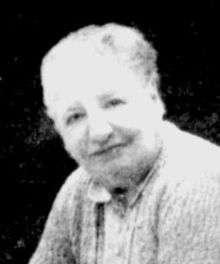Jessie Franklin Turner
Jessie Franklin Turner (10 December 1881 – 1956) was an American fashion designer based in New York in the early 20th century. She was notable for being one of the first American designers to create unique designs, rather than imitating or copying Paris fashions.
Jessie Franklin Turner | |
|---|---|
 Jessie Franklin Turner in 1954. | |
| Born | Jessie Franklin Turner 10 December 1881 St. Louis, Missouri |
| Died | 1956 (aged 74-75) |
| Nationality | American |
Label(s) | Jessie Frankiin Turner; Winifred Warren Inc. |
| Spouse(s) | Charles Hiram Ferguson |
| Parent(s) | Richard Major Turner; Louise Pullen Franklin. |
Personal life
Franklin Turner stated that she was born in St. Louis in Missouri, to Richard Major Turner of Wheeling, West Virginia, and Louise Pullen Franklin of Plymouth, Massachusetts on 10 December 1881, although Morris de Camp Crawford presented her as being a Virginian native from the state's tidewater region when promoting her alongside other American textile and fashion designers in his 1916-1922 "Made in America" campaign.[1] She married Charles Hiram Ferguson, but retained her maiden name professionally.[1] She died in 1956.
Career
Franklin Turner worked as a lingerie buyer for Bonwit Teller between 1916 and 1918,[2] then went on to design for their custom salon under the name of Winifred Warren Inc.[1][3] In 1919 the American Museum of Natural History featured a selection of 'Winifred Warren' teagowns and lingerie for Bonwit Teller in their Exhibition of Industrial Art in Textiles and Costumes.[3]
Franklin Turner's shop, which she opened in 1923, was based at 410 Park Avenue, New York.[4] Developing her work by directly draping on a model, Franklin Turner was known particularly for flowing tea gowns and exotic evening dresses, often made in fabrics of her own design.[4][5][6] In 1923 she acknowledged the influence of historical and ethnographic textiles in the Brooklyn Museum's collections on many of her most successful designs.[7] These influences continued throughout her career. In 1938, a day dress based on an Ainu coat was exhibited alongside the original coat in the second annual exhibition of New York's Museum of Costume Art.[8] Franklin Turner was one of the directors of this museum, which was located in the Rockefeller Center on the fourth floor.[9]
In 1923 Paul Poiret was quoted as having declared Franklin Turner "the only designer of genius in the United States."[7] When the designer Elizabeth Hawes returned to New York in 1928 to launch her American couture house, she noted that Jessie Franklin Turner was possibly the only American dressmaker at that time to offer high end clothing that was completely her own work, and not made in imitation of Paris fashions.[4][10]
Although Franklin Turner reportedly never met any of her clients,[4] she was known for her unique and striking clothing for individualistic dressers such as the textile designer Dorothy Liebes and the socialite and fashion icon Millicent Rogers.[5][11] She retired in 1943.[2]
Exhibitions
- 1919: Exhibition of Industrial Art in Textiles and Costumes, American Museum of Natural History. Selection of 'Winifred Warren' teagowns and lingerie designed for Bonwit Teller.[3]
- 1938: Second annual exhibition at New York's Museum of Costume Art. Ainu-inspired day dress.[8]
- 1942: Renaissance in Fashions, 1942 at the Metropolitan Museum of Art. Velvet and brocade teagown.[12]
- 2013-14 An American Style, Bard Graduate Center. The 1919 AMNH exhibition revisited.[13]
Garments by Jessie Franklin Turner are in the permanent collection of the Metropolitan Museum of Art's Costume Institute,[5] the Art Institute of Chicago,[14] and the Rhode Island School of Design Museum.[15]
References
- Mears, Patricia E. (September 23–26, 1998). "Jessie Franklin Turner: American Fashion and "Exotic" Textile Inspiration". Creating Textiles: Makers, Methods, Markets. Proceedings of the Sixth Biennial Symposium of the Textile Society of America, Inc. New York, NY. Textile Society of America, Inc.: 431–440. Summary on University of Nebraska Digital Commons, accessed 4 January 2015
- Staff writer (31 December 1954). "Palm Beach Winter Resident Recalls First Big Purchase". Palm Beach Daily News. Retrieved 4 January 2015.
- Rose, Evan M. "Tea Gowns: Winifred Warren (Jessie Franklin Turner) for Bonwit Teller. Exhibited at the American Museum of Natural History". American Art in American Dress: Revisiting the Exhibition of Industrial Art in Textiles and Costumes 1919. Archived from the original on 4 January 2015. Retrieved 4 January 2015.
- Milbank, Caroline Rennolds (1996). New York fashion : the evolution of American style (Paperback ed.). New York: Abrams. pp. 86, 89, 122. ISBN 9780810926479.
- "Dress, ca. 1937". The Collection Online. Metropolitan Museum of Art. Retrieved 1 January 2015.
- "Gold lamé evening dress, ca. 1933". The Collection Online. Metropolitan Museum of Art. Retrieved 1 January 2015.
- Appleton Reed, Helen (20 May 1923). "The Secret of Art Appreciation". The Brooklyn Daily Eagle. Retrieved 8 March 2015 – via Newspapers.com.
- Staff writer (21 June 1938). "Ainu Garb Inspires a New Ensemble". The Piqua Daily Call. Retrieved 8 March 2015 – via Newspapers.com.
- Blanck, Katherine (15 October 1940). "Design Sources Seen at Costume Art Exhibit". The Brooklyn Daily Eagle. Retrieved 8 March 2015 – via Newspapers.com.
- Hawes, Elizabeth (1938). Fashion Is Spinach. Random House. pp. Chapter 11.
- "Bedjacket, ca. 1930". The Collection Online. Metropolitan Museum of Art. Retrieved 1 January 2015.
- Adrian, Tracy (29 May 1942). "Renaissance in Fashion". The Evening News, Harrisburg, Pennsylvania. Retrieved 8 March 2015.
- "An American Style: About the Exhibition". The Gallery at Bard Graduate Center. Archived from the original on 4 January 2015. Retrieved 4 January 2015..
- Embroidered silk and velvet tea gown in the collection of the Art Institute of Chicago
- "Jessie Franklin Turner in the RISD Museum". Rhode Island School of Design Museum Collections Search. RISD Museum. Retrieved 4 January 2015.
Further reading
- Tartsinis, Ann (2013). An American Style: Global Sources for New York Textile and Fashion Design, 1915-1928. New York: Yale University Press / Bard Graduate Center. pp. 65, 80, 113–114. ISBN 978-0-300-19943-7.